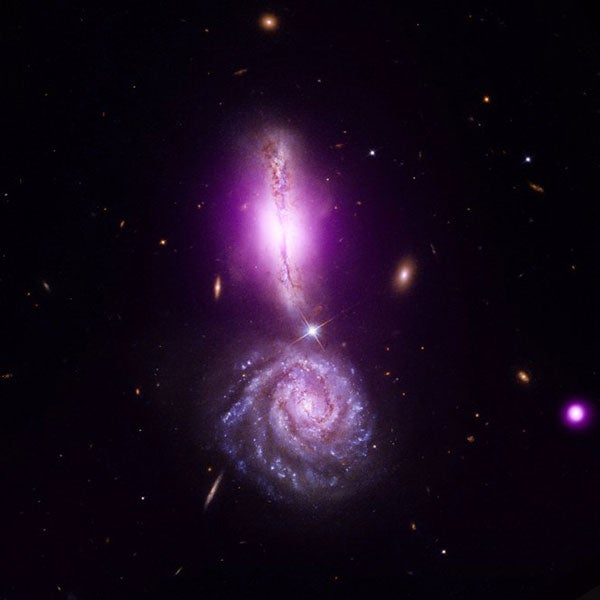Because it is bright in infrared light, VV 340 is classified as a Luminous Infrared Galaxy (LIRG). These observations are part of the Great Observatories All-Sky LIRG Survey (GOALS) combining data from Chandra, Hubble, NASA’s Spitzer Space Telescope, the Galaxy Evolution Explorer (GALEX), and ground-based telescopes. The survey includes more than 200 LIRGs in the local universe. A chief motivation of this study is to understand why LIRGs emit so much infrared radiation. These galaxies generate energy at a rate that is tens to hundreds of times larger than that emitted by a typical galaxy. An actively growing supermassive black hole or an intense burst of star formation is often invoked as the most likely source of the energy.
Work on the full GOALS survey is ongoing, but preliminary analysis of data for VV 340 provides a good demonstration of the power of observing with multiple observatories. The Chandra data show that the center of VV 340 North likely contains a rapidly growing supermassive black hole that is heavily obscured by dust and gas. The infared emission of the galaxy pair, as observed by Spitzer, is dominated by VV 340 North, and also provides evidence for a growing supermassive black hole. However, only a small fraction of the infrared emission is generated by this black hole.
By contrast, most of the ultraviolet and short wavelength optical emission in the galaxy pair — as observed by GALEX and Hubble — comes from VV 340 South. This shows that VV 340 South contains a much higher level of star formation. VV 340 appears to be an excellent example of a pair of interacting galaxies evolving at different rates.
Because it is bright in infrared light, VV 340 is classified as a Luminous Infrared Galaxy (LIRG). These observations are part of the Great Observatories All-Sky LIRG Survey (GOALS) combining data from Chandra, Hubble, NASA’s Spitzer Space Telescope, the Galaxy Evolution Explorer (GALEX), and ground-based telescopes. The survey includes more than 200 LIRGs in the local universe. A chief motivation of this study is to understand why LIRGs emit so much infrared radiation. These galaxies generate energy at a rate that is tens to hundreds of times larger than that emitted by a typical galaxy. An actively growing supermassive black hole or an intense burst of star formation is often invoked as the most likely source of the energy.
Work on the full GOALS survey is ongoing, but preliminary analysis of data for VV 340 provides a good demonstration of the power of observing with multiple observatories. The Chandra data show that the center of VV 340 North likely contains a rapidly growing supermassive black hole that is heavily obscured by dust and gas. The infared emission of the galaxy pair, as observed by Spitzer, is dominated by VV 340 North, and also provides evidence for a growing supermassive black hole. However, only a small fraction of the infrared emission is generated by this black hole.
By contrast, most of the ultraviolet and short wavelength optical emission in the galaxy pair — as observed by GALEX and Hubble — comes from VV 340 South. This shows that VV 340 South contains a much higher level of star formation. VV 340 appears to be an excellent example of a pair of interacting galaxies evolving at different rates.










